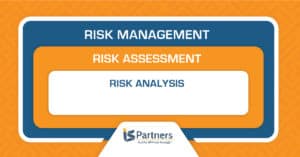Risk management, risk assessment, and risk analysis are all key components of an effective risk management strategy. However, they each have distinct meanings and functions. Risk management involves identifying, assessing, and prioritizing risks, and then implementing measures to mitigate or control those risks. Risk assessment is the process of determining how likely it is that something bad will happen and what the consequences could be. It involves understanding the nature of the risk, its causes, and possible outcomes. Risk analysis is the process of gathering and evaluating information to understand the level of risk associated with a particular situation or event. This involves identifying potential threats and vulnerabilities, assessing the possible impact of those threats, and determining the likelihood that they will occur.
What Is Risk?
Risk is the chance that something will go wrong. In business, we usually talk about risks in terms of possible negative consequences of an event or decision. For example, if you’re thinking about starting a new business, there’s a risk that it might not be successful.
Even though risks are a part of doing business, it’s crucial to find ways to manage them swiftly and effectively. Risks can often develop out of nowhere, so it’s important to be proactive in identifying and managing them. By taking steps to minimize the threats and maximize the potential of risks, we can help protect our businesses from potentially devastating consequences.
Even though risks are a part of doing business, we must identify and manage them swiftly and effectively since they can often develop out of nowhere, creating the possibility for greater risks and damages. It is crucial to find ways to manage risks with the goal of minimizing their threats and maximizing their potential. Risks come from a variety of sources, which include the following:
- Uncertainties in financial markets and the economy.
- Threats associated with project failures at any phase include design, development, production, or maintenance of life cycles.
- Legal liabilities.
- Credit risk.
- Threat of natural or man-made disasters.
- Security and cybersecurity risk.
- Impact of uncertain or unpredictable events, such as a pandemic.
- Competitive risk.
- Fallout from a company’s damaged reputation.
- Compliance risk.
- Third-party risk that comes with relying on external suppliers and vendors.
To help you better understand various risks, there is a set of international standards for information security that can help. Together, the International Organization for Standardization (ISO) and the International Electrotechnical Commission (IEC) create and publish the ISO 270000 standards cooperatively for better guidance.
Risk Assessment vs. Risk Management vs. Risk Analysis

- Risk management is the macro-level process of assessing, analyzing, prioritizing, and making a strategy for mitigating threats and managing risk to an organization’s assets and earnings.
- Risk assessment is a meso-level process within risk management. It aims to breaks down threats into identifiable categories and define all the potential impact of each risk.
- Risk analysis is the micro-level process of measuring risks and their associated impact.
t can become confusing trying to sift through the different terms dealing with risk, including risk assessment, risk management, and risk analysis. The main difference is breadth. Let’s take a closer look at what differentiates these terms.
Risk Management
“The purpose of risk management is not to change the future, not to explain the past.” – Dr. Dan Borge, a financial expert and former aeronautical engineer who designed the RAROC risk-management system and wrote The Book of Risk.
Instead, cybersecurity risk management is the overarching umbrella when it comes risk. It includes both risk assessment and risk analysis.
To manage risk, it requires the identification, analysis, evaluation, and prioritization of current and potential risks. This allows you to address loss exposures, monitor risk control and financial resources in order to minimize possible adverse effects of potential loss. Further, solid risk management strategies within your business model give you the ability to maximize the realization of available opportunities to avoid risk.
Risk Assessment
Risk assessment helps you identify and categorize risks. Plus, it provides an outline for potential consequences.
Risk assessment definition: an analysis involving processes and technologies that help identify, evaluate and report on any risk-related concern. According to NIST 800-30, risk assessment is a “key component” of the risk management process and is primarily focused on the identification and analysis phases of risk management.
In it’s entirety, security risk assessment meaning that it involves the following steps:
- Identify the critical assets and sensitive data,
- Build a risk profile for each asset,
- Determine cybersecurity risks for each asset,
- Mapping how critical assets are linked,
- Prioritize which assets to address in case of a security threat,
- Create a mitigation plan with security controls to eliminate or mitigate the impact of each risk,
- Continually monitor risks, threats, and vulnerabilities.
Risk Analysis
Risk analysis is the crucial evaluation component within the broader risk management techniques and assessment processes. A preliminary factor analysis of information risk determines the significance of identified risk factors identified in risk assessments and provides. Plus, it qualifies risk, measuring the likelihood of hazards occurring and tolerances for certain events. One example is when an auditor calculates the probability and magnitude of a potential loss.
Scoring the risks identified takes into account the likelihood of occurrence and the estimated extent of possible impact. Together, this makes it possible to prioritize risks and set a strategy for mitigating them.
Related article: Business Leaders’ Top Concerns as Enterprise Risk Rises in 2023.
Do You Feel Confident About Your Organization’s Risk Management Strategy?
Is your team discussing risk management? Do you worry that there are risk factors that you are missing during the risk assessment and risk analysis phases of enterprise risk management? Our team at I.S. Partners, LLC. can help you get up to speed on any lurking risks to help you find ways to prevent and mitigate them for both cloud computing systems and on-site infrastructures.
Fill out our contact form below or call us at 215-675-1400 today to find out how we can help with risk management, risk assessment and risk analysis.














